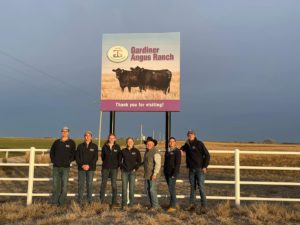15 May Exclusive AI breeding could boost Australian beef production
There’s potential for Australian beef producers to accelerate the genetic improvement of their herds and boost production by breeding exclusively with artificial insemination (AI) and embryo transfer (ET) systems.
Australian Intercollegiate Meat Judging (ICMJ) team member Austin Smith toured the US in January for a series of training events and competitions and also spent time investigating breeding technologies at the Gardiner Angus Ranch (GAR) in Kansas, which has phased out natural breeding in favour of AI and ET.
While relatively unique in being 100% AI and ET, Mr Smith said the Gardiner Angus Ranch breeding system generated huge opportunities to access superior genetics and accelerate on-farm genetic improvements. “In a traditional extensive management system, an average cow will produce one calf per year, equating to 10 calves in her lifetime,” Mr Smith said.
“Embryo transfer technologies allow producers to select a genetically superior female, generate mass ovulation through hormone therapy and collect multiple eggs per cycle.”
Mr Smith said the fertilised eggs were then transferred into surrogates to produce multiple offspring of a genetically desirable cow to assist in rapid advancements in a herds genetic gain.
Other benefits of artificial insemination breeding systems include synchronization of oestrus, shorter calving windows and little to no management of bulls with the advantage of sourcing semen from genetically superior bulls without them being on-farm.
Mr Smith said GAR transfers approximately 2,000 embryos a year with a success rate of more than 60 per cent and recipient cows that don’t accept the embryos are artificially inseminated, usually with semen from the same bulls. “GAR rely on genetic predictors for sire and embryo donor selection for on-farm use, as well as provide EPDs (expected progeny differences) on all animals sold from the ranch,” he said.
EPDs are the US equivalent of an estimated breeding value (EBV) and have been used in the US industry for more than 40 years with continual additions of new production traits, updated values and increased accuracy providing producers with more options to select from.
Mr Smith said while the use of AI and genomic evaluation is commonplace among Australian producers, commercial bulls were still widely incorporated into AI programs as “follow-up” bulls. This was likely due to limitations such as cost and management of AI and ET technologies, especially for smaller scale producers. “The ability to identify and select animals based on genetic merit specific to the desired trait has seen a rapid increase in genetic gain across the industry. These improvements have allowed the US beef industry to grow to the scale it is today, which is an ambition the Australian industry strives to achieve,” Mr Smith said.
However, Mr Smith said Australia’s key success remains its export market, with one of the highest global reputations for consistent quality beef. “Continuing to increase production quality through genetic improvements, strengthening market access and maintaining quality assurance is key to ensuring the future success of the Australian beef industry,” Mr Smith said.
This year’s ICMJ US tour conducted in January 2023 spanned three weeks, seven states, two inter-collegiate competitions and more than 40 industry experiences, exposing participants to the broad spectrum of the US red meat supply chain. Sponsored by Meat and Livestock Australia (MLA) and the Australian Meat Processor Corporation (AMPC) more than 130 students over 29 years have taken part in the ICMJ US Tour.
Since returning from the US, Mr Smith, a Murdoch University agricultural science graduate, has embarked on a master’s degree in meat science. “The ICMJ program has really broadened my understanding of the supply chain and how decisions made on farm can affect the quality and price of the end product,” Mr Smith said. “The US tour really highlighted to me the differences between the Australian and US red meat industries and how global dynamics can affect Australian producers and processors,” he said.
“ICMJ also opened my eyes to the range of career paths and opportunities within the red meat industry and the networks created through ICMJ have been extremely helpful for my current role.”
- Mr Smith’s full report is available at: https://icmj.com.au/wp-content/uploads/2023/03/Beef-Genetics_AustinSmith_ICMJ-US-TRIP-2023.pdf


